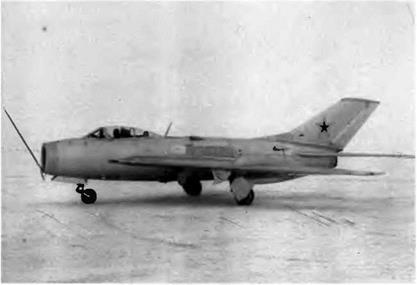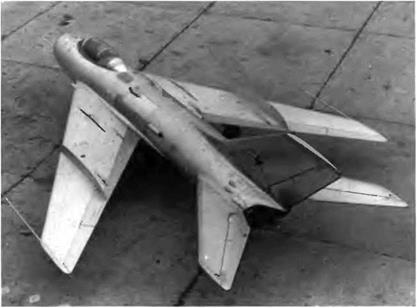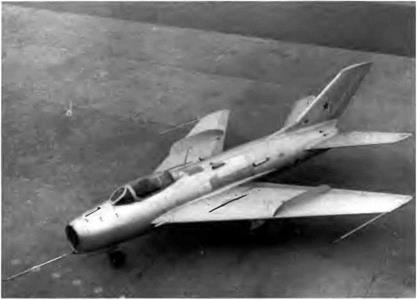MiG-19 / SM 9/1
After the failure of the SM-2, the only way for the project to move forward was to equip the AM-5F turbojet with a modified afterburner. Once modified, the engine was named the AM-9 В (AM-9 being its preliminary design designation). Its dry thrust was now 2,550 daN (2,600 kg st), rising to 3,185 daN (3,250 kg st) when reheated and 6,370 daN (6,500 kg st) when paired—a figure that met the needs of the OKB engineers, Two test engines were installed in the SM-2B airframe. With these two AM-9Bs and a few modifications of the fuselage to accommodate the new afterburners and protect the structure from high temperatures, the SM-2B became the SM-9/1. The development of this aircraft was ordered by decree no. 2181-887 of the USSR council of ministers, dated 15 August 1953.
All flight controls were boosted, and the nonrotating tailplane was fitted with an elevator. The midwing sweepback C/4 was 55 degrees.
|
The air probe on the SM-9/1 could be hinged upward to avoid any damage that could be caused by ramp vehicles. |
and the stabilizer sweep was 55 degrees at the leading edge. The cockpit was pressurized and air-conditioned with cold – and hot-air bleeds from the engine. The temperature inside the cockpit remained uniform thanks to a special temperature regulator with an automatic display. The ejection seat was of the curtain type, a device that protected the pilot’s hands and face when ejecting at high speeds. The tail chute was housed in a canister under the rear fuselage. Armament consisted of three NR-23 cannons, two in each wing root and one on the lower right side of the fuselage.
The team in charge of the SM-9 tests was G. A. Sedov, chief pilot, V. A. Arkhipov, chief engineer, and V. A. Mikoyan, Arkhipov’s assistant. The new engines were monitored by two specialists from the Mikulin ОКБ, 1.1. Gneushev and V. P. Shavrikov. The SM-9’s first flight took place on 5 January 1954 with Sedov at the controls. During that flight the engines ran smoothly but the afterburners were not used. The pilot found the aircraft easy to handle and capable of supersonic speed. During the second flight Sedov lit up the afterburners and broke the sound barrier, a procedure that he repeated many times in the course of the tests. On 12 September 1954 the factory tests ended; on 30 September the state acceptance trials commenced.
The SM-9 was clearly an aircraft with a future The official test report made the point this way: "The SM-9/1 ’s performance data are far better than those of the MiG-17F. The former is 380 km/h [205 kt]
|
|
The main features of the SM-9/1 are its Fowler-type flaps, fixed stabilizer with elevators and deep-chord wing fences.
|
|
This photograph was taken before the wing-root cannons were installed. Their place was occupied by a provisional fairing.
faster at 10,000 m [32,800 feet], and its service ceiling is 900 m [2,950 feet] higher." This report, approved by Marshal Zhigarev, the air force commander-in-chief, recommended the SM-9 (designated the MiG-19 by the military) for its units.
Well before the end of the state trials, the council of ministers issued decree no. 286-133 on 17 February 1954 ordering the mass production of the MiG-19 in two factories, one in Gorki and the other in Novosibirsk. Initiating a rather uncommon procedure, the council of ministers ordered the ministry of aircraft production to build (and the ministry of defense to accept) the first fifty aircraft and the first hundred turbojets from the design office blueprints and not, as was customary, from the production sets of drawings, because the latter were not yet ready. The first MiG-19s were delivered to the air force in March 1955.
Performance
Max speed, 1,451 km/h at 10,000 m (784 kt at 32,800 ft); max speed at sea level, 1,150 km/h (620 kt); climb to 10,000 m (32,800 ft) in 1.1 min; to 15,000 m (49,200 ft) in 3.7 min; service ceiling, 17,500 m (57,400 ft).













